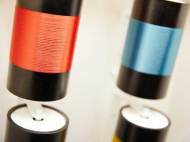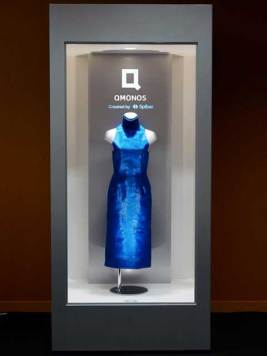Spiber Qmonos – a tough and lightweight artificial spider silk
 A Japanese startup called Spiber Inc. has created an artificial spider silk using synthesized genes which persuade bacteria to produce fibroin, a structural protein found in spider silk. Researchers have developed technologies to cultivate these bacteria efficiently and weave the fibroin into fabric. The protein derived from fibroin has been given the name “QMONOS” (from the Japanese phrase “kumo-no-su” meaning spider web).
A Japanese startup called Spiber Inc. has created an artificial spider silk using synthesized genes which persuade bacteria to produce fibroin, a structural protein found in spider silk. Researchers have developed technologies to cultivate these bacteria efficiently and weave the fibroin into fabric. The protein derived from fibroin has been given the name “QMONOS” (from the Japanese phrase “kumo-no-su” meaning spider web).
Spider silk consists of chains of amino acids spun by spiders. Spider silk has exceptional mechanical properties such as high tensile strength and extensibility. This unique combination of properties enables a silk fiber to absorb a lot of energy before breaking.
Despite being lightweight, it is regarded as the toughest fiber on the planet. For example, if a spider web was made with a fiber that has 1 cm (0.4 inches) in diameter, it could catch a jumbo jet. It is also seven times stronger than aramid fiber which is used for making bulletproof vests. Furthermore, it weights 1/6th the weight of steel and 40 percent less than carbon fiber.
Spiders are territorial predators that are hard to farm to produce its silk. The silk used for fabrics is harvested from silkworms because they are friendly and thousands of them can live together happily. Unlike silkworms, spiders are not so friendly and they tend to eat one another. Furthermore, spider farming is costly because it takes around 400 spiders to produce 0.85 square meters (one square yard) of spider silk cloth.
Spider silk has complex molecular structure, so it is hard to create artificial spider silk genes. However, researchers at Spiber managed to solve this problem by building their own system of Gene Synthesis which is able to synthesize any fibroin gene within 3 working days. They have developed a library of more than 250 types of artificial spider silk genes to date.
With effective application of bioinformatics, researchers can analyze amino acid sequences and gene arrangements in order to maximize strength, stability, flexibility, functionality, and molecule thermo-stability. Modified candidate genes are synthesized and then reproduced with their own protein express system by bacteria.
The source of nutrients for bacteria is sustainable biomass. Fibroin is produced through fermentation and it is then put through the refining method. The fiber is then formed from the polymer QMONOS in a spinning process. QMONOS can also be transformed into film, gel, sponge, powder, and nanofiber form.
Spiber researchers have developed spinning technology from scratch and have achieved fiber toughness comparable to natural spider silk. They developed the basics of fiber forming technology that can be scaled up for mass production. Aside being used in clothing, the huge variety of QMONOS materials could be used in sports, space exploration, auto-industry and for new line of accessories.










author
In collaboration with Kojima Industries Corporation, Spiber researchers are currently building a trial manufacturing research plant capable of producing more than 100kg (220 pounds) of QMONOS fiber per month. The plant will be completed and fully operational in 2015.
The plan is to begin production at a scale of 10 tons in the first year and after that they will be able to start supplying worldwide.
Very good. Would love to get more information please.